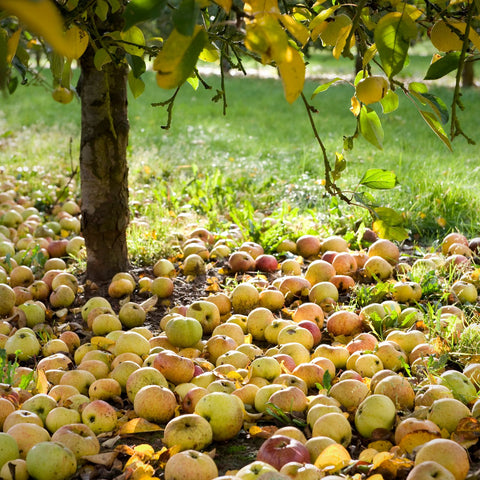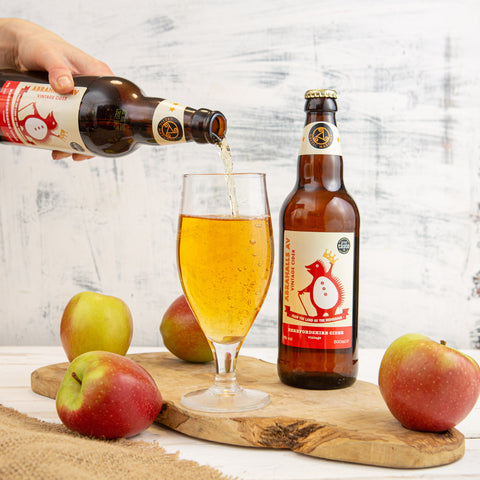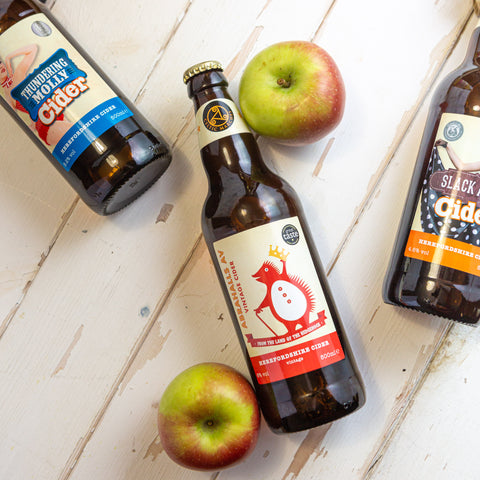Top of the Crops: The 8 Best Cider Apple Varieties

Did you know...there are over 365 cider apple varieties! That's an apple a day for an entire year...although you wouldn't want to munch down on all of them (unless you like the kind of facial contortions you get from eating lemons?!); many cider apples are not destined to be eaten - they're too bitter, or have mega-tough skins. But they make bloomin' gorgeous cider...
Our Head Of Apples, Rob, has his faves, which he uses to create the Celtic Marches range of lip-smackingly good ciders. There's not much Rob doesn't know about apples. Or apple trees, for that matter. Here he shares his 'incider knowledge' (like what we did there?!) on his favourite eight:

Dabinett
The Godfather of all cider apples, this classic English variety produces a 'bittersweet' juice and is one of the most reliable and easy cider varieties to grow. Testament to its patriarchal status, the Dabinett can be used all by itself to produce a single-varietal, full-bodied medium-dry cider. It's also a beauty to blend. Its high resistance to apple scab and canker make it the Arnie Schwarzenegger of the orchard...
Ellis Bitters
If trees were rockstars the Ellis Bitter would be the Meatloaf of the Apple Tree world. BIG. The fruits are big, the yield is big and it's as vigorous as a bat out of hell...The flesh is mega coarse and full of tannins and the tree has good disease resistance. You'll get a good quality, mild, bittersweet juice from this one.
Harry Masters
If Ellis Bitters is Meatloaf then Harry Masters is more of a Rolling Stone....(alright, alright, enough already!). A true vintage cider apple, believed to have derived from the loins of the much-respected Yarlington Mill variety and named after Mr. Masters who worked as the miller at Yarlington Mill in Somerset.
A good quality bittersweet fruit, it produces a great juice with soft, astringent tannin. You can get a decent, full-bodied cider using just the juice of these fruit.
Ashton Bitters
The silent but moody type, Ashton Bitters is as hard as nails, and, as his namesake suggests, pretty bitter to boot. Nonetheless, his tough set of characteristics has earned this brute of a fruit a lot of respect amongst those in the know. (Early season English bittersweet for those of you taking notes...).
Three Counties
Our Ben Stokes of the team, Three Counties is a classy all-rounder; early maturing, a vigorous grower with a good centre leader habit (that's the main upright branch in the middle). It crops regularly with fruit ready to press by mid/late September. You'll get a sweet juice, low in acid with a sturdy astringency.
Yarlington Mill
Despite its rocky start in life (it was first found growing out of a wall by the water wheel at Yarlington, Somerset in the late 19th century), the Yarlington Mill is a cracking contender. It behaves itself in the orchard, growing nicely upright, and rewards us with a sterling crop and high yield, year on year. Expect a medium bittersweet juice with a good flavour and fruity aroma.
Michelin
Compared to the others on this list, this small green apple is a bit of a plain Jane, but what it lacks in charm, it makes up for in quantity. The Michelin apple tree will produce a big ole bounty each harvest. Not one of our favourites to prune, with branches veering towards the vertical, but it's a cracker to blend so we turn a blind eye to its flaws...
Jane
No offence, Jane, but you smell like a farmyard - in a good way! On top of that you are sweet and astringent, and we love your medium-sized fruit. This relatively new member of the family harvests late September, early October and crops pretty heavily on reasonably manageable tree growth. Blossom can be early, so we have to keep 'em peeled for the frost in Spring.
So, that's the team. They all crop annually and bring their own unique qualities to our cider.

Grow Your Own
For anyone looking to plant heritage and variety trees, have a look at the following:
Bens Red, Brown Snout, Captain Broad, Dabinett, Ellis Bitters, Fillabarrel, Harry Masters Jersey, Golden Spire, Katy, Morgan sweet, Porters Perfection, Redstreak, Red Stoke, Tremeletts Bitter, Kingston Black, and Dymock Red.
They will all crop at roughly the same time - October/November - except the Katy which crops in August (Katy always likes to make an entrance...).
Andrew Howard at Heritage Fruit Trees is a wealth of knowledge and will be only too happy to help you in your search to create a winning crop of cider apple trees.
Happy growing!

